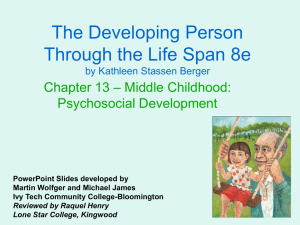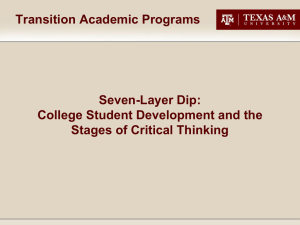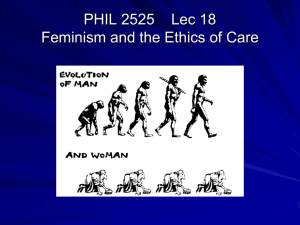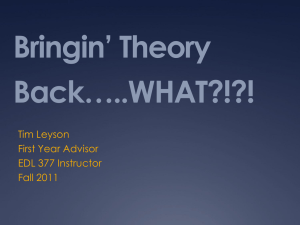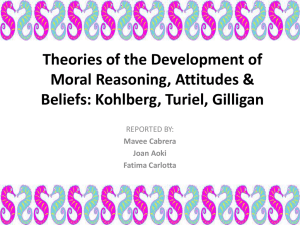Values-Kohlberg stages of moral development
advertisement
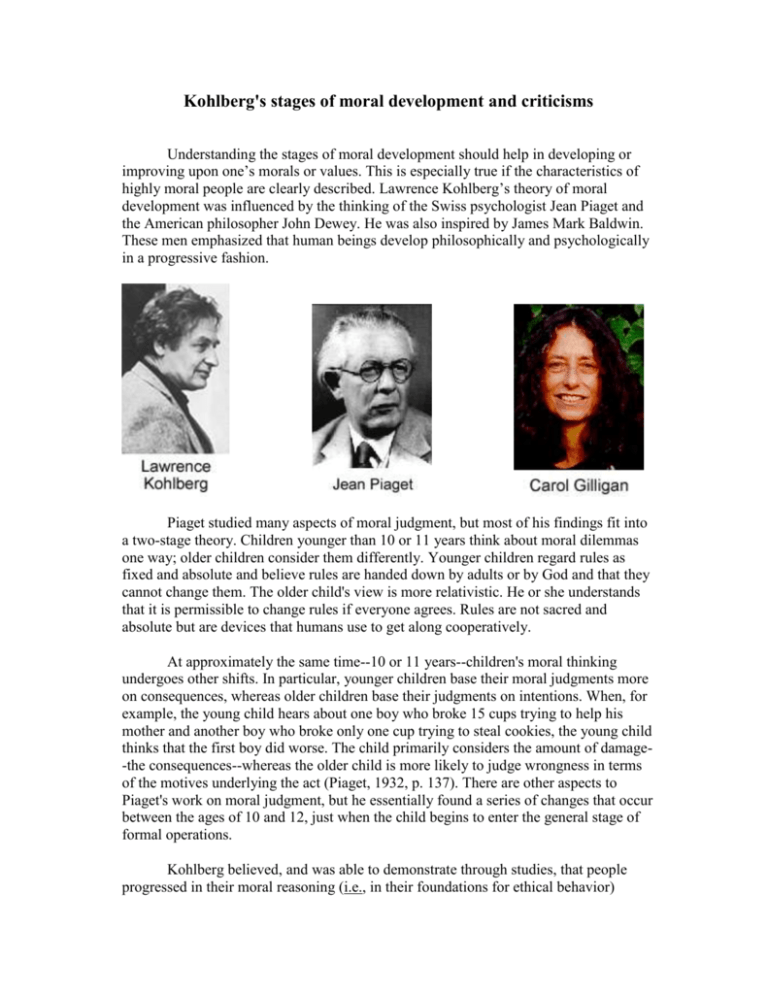
Kohlberg's stages of moral development and criticisms Understanding the stages of moral development should help in developing or improving upon one’s morals or values. This is especially true if the characteristics of highly moral people are clearly described. Lawrence Kohlberg’s theory of moral development was influenced by the thinking of the Swiss psychologist Jean Piaget and the American philosopher John Dewey. He was also inspired by James Mark Baldwin. These men emphasized that human beings develop philosophically and psychologically in a progressive fashion. Piaget studied many aspects of moral judgment, but most of his findings fit into a two-stage theory. Children younger than 10 or 11 years think about moral dilemmas one way; older children consider them differently. Younger children regard rules as fixed and absolute and believe rules are handed down by adults or by God and that they cannot change them. The older child's view is more relativistic. He or she understands that it is permissible to change rules if everyone agrees. Rules are not sacred and absolute but are devices that humans use to get along cooperatively. At approximately the same time--10 or 11 years--children's moral thinking undergoes other shifts. In particular, younger children base their moral judgments more on consequences, whereas older children base their judgments on intentions. When, for example, the young child hears about one boy who broke 15 cups trying to help his mother and another boy who broke only one cup trying to steal cookies, the young child thinks that the first boy did worse. The child primarily considers the amount of damage-the consequences--whereas the older child is more likely to judge wrongness in terms of the motives underlying the act (Piaget, 1932, p. 137). There are other aspects to Piaget's work on moral judgment, but he essentially found a series of changes that occur between the ages of 10 and 12, just when the child begins to enter the general stage of formal operations. Kohlberg believed, and was able to demonstrate through studies, that people progressed in their moral reasoning (i.e., in their foundations for ethical behavior) through a series of six identifiable stages that could be more generally classified into three levels. Kohlberg’s six stages might be viewed in this form: Level 1 (Pre-Conventional) (up to age 9) 1. Obedience and punishment orientation 2. Self-interest orientation Level 2 (Conventional) (10 years old to adolescence) 3. Interpersonal accord and conformity (a.k.a. The good boy/good girl attitude) 4. Authority and social-order maintaining orientation (a.k.a. Law and order morality) Level 3 (Post-Conventional)(adulthood) 5. Social contract orientation 6. Universal ethical principles (a.k.a. Principled conscience) The first level of moral thinking is that generally found at the elementary school level. In the first stage of this level, people behave according to socially acceptable norms because they are told to do so by some authority figure (e.g., parent or teacher). This obedience is compelled by the threat or application of punishment. The second stage of this level is characterized by a view that right behavior means acting in one's own best interests. The second level of moral thinking is that generally found in society, hence the name "conventional." The first stage of this level (stage 3) is characterized by an attitude which seeks to do what will gain the approval of others. The second stage is one oriented to abiding by the law and responding to the obligations of duty. The third level of moral thinking is one that Kohlberg felt is not reached by the majority of adults. Its first stage (stage 5) is an understanding of social mutuality and a genuine interest in the welfare of others. The last stage (stage 6) is based on respect for universal principle and the demands of individual conscience. While Kohlberg always believed in the existence of Stage 6 and had some nominees for it, he could never get enough subjects to define it, much less observe their longitudinal movement to it. Between the Stage 4 (“law and order”) and Stage 5, there is a transitional stage, maybe Stage 4.5. . Many college-age students in the 1960s and early 1970s, for example, saw conventional morality as relative and arbitrary, but had not yet discovered universal ethical principles or their own adulthood and parenthood. This stage thus involved a hedonistic ethic of "do your own thing." This was observed in the hippie culture of the l960s. Disrespect for conventional morality was especially infuriating to the Stage 4 mentality (“We will have law and order”), and indeed was calculated to be irritating to those over 30. Certainly this did not apply to all Baby Boomers in the 1960s but it did apply to many. Kohlberg believed progression through these stages was one stage at a time. That is, individuals could not skip stages. They could not, for example, move from an orientation of selfishness to the law and order stage without passing through the good boy/girl stage. They could only come to a comprehension of a moral rationale one stage above their own. Thus, according to Kohlberg, it was important to present them with moral dilemmas for discussion which would help them to see the reasonableness of a "higher stage" morality and encourage their development in that direction. The last comment refers to Kohlberg's moral discussion approach. He saw this as one of the ways in which moral development can be promoted through formal education. Note that Kohlberg believed, as did Piaget, that most moral development occurs through social interaction. The discussion approach is based on the insight that individuals develop as a result of cognitive conflicts at their current stage. Another way to view the stages is as follows, taken primarily from Piaget (1932), Kohlberg (1975), and Rosen (1980): Stage 1: Respect for power and punishment. A young child (age 1-5) decides what to do--what is right--according to what he/she wants to do and can do without getting into trouble. To be right, you must be obedient to the people in power and, thus, avoid punishment. Motto: "Might makes right." Stage 2: Looking out for #1. Children (age 5-10) tend to be self-serving. They lack respect for the rights of others but may give to others on the assumption that they will get as much or more in return. It is more a matter of "you scratch my back and I'll scratch yours," instead of loyalty, gratitude, or justice. Motto: "What's in it for me?" Stage 3: Being a "Good Boy" or "Nice Girl." People at this stage (age 8-16) have shifted from pleasing themselves to pleasing important others, often parents, teachers, or friends. They seek approval and conform to someone else's expectations. When they are accused of doing something wrong, their behavior is likely to be justified by saying "everyone else is doing it" or "I didn't intend to hurt anyone." Motto: "I want to be nice." Stage 4: Law and order thinking. The majority of people 16 years old and older have internalized society's rules about how to behave. They feel obligated to conform, not any longer to just family and friends, but also to society's laws and customs. They see it as important to do one's duty to maintain social order. Leaders are assumed to be right; individuals adopt social rules without considering the underlying ethical principles involved. Social control is, therefore, exercised through guilt associated with breaking a rule; the guilt in this case is an automatic emotional response, not a rational reaction of conscience based on moral principles (as in stage 6). People at this stage believe that anyone breaking the rules deserves to be punished and "pay their debt to society." Motto: "I'll do my duty." Stage 5: Justice through democracy. People at this stage recognize the underlying moral purposes that are supposed to be served by laws and social customs; thus, if a law ceases to serve a good purpose, they feel the people in a democracy should get active and change the law. Thought of in this way, democracy becomes a social contract whereby everyone tries continually to create a set of laws that best serves the most people, while protecting the basic rights of everyone. There is respect for the law and a sense of obligation to live by the rules, as long as they were established in a fair manner and fulfill an ethical purpose. Only about 20-25% of today's adults ever reach this stage and most of those that do supposedly only get there after their mid-twenties. Motto: "I'll live by the rules or try to change them." Stage 6: Deciding on basic moral principles by which you will live your life and relate to everyone fairly. These rather rare people have considered many values and have decided on a philosophy of life that truly guides their life. They do not automatically conform to tradition or others' beliefs or even to their own emotions, intuition, or impulsive notions about right and wrong. Stage 6 people carefully choose basic principles to follow, such as caring for and respecting every living thing, feeling that we are all equal and deserve equal opportunities, or, stated differently, the Golden Rule. They are strong enough to act on their values even if others may think they are odd or if their beliefs are against the law, such as refusing to fight in a war. Motto: "I'm true to my values." Example Kohlberg used moral dilemmas to determine which stage of moral reasoning a person uses. The dilemmas are short stories in which a person has to make a moral decision. The participant is asked what this person should do. A dilemma that Kohlberg used in his original research was the druggist's dilemma: Heinz steals the drug In Europe, a woman was near death from a special kind of cancer. There was one drug that the doctors thought might save her. It was a form of radium that a druggist in the same town had recently discovered. The drug was expensive to make, but the druggist was charging ten times what the drug cost him to make. He paid $200 for the radium and charged $2,000 for a small dose of the drug. The sick woman's husband, Heinz, went to everyone he knew to borrow the money, but he could only get together about $ 1,000 which is half of what it cost. He told the druggist that his wife was dying and asked him to sell it cheaper or let him pay later. But the druggist said: "No, I discovered the drug and I'm going to make money from it." So Heinz got desperate and broke into the man's store to steal the drug-for his wife. (Kohlberg, 1963, p. 19) Should Heinz break into the laboratory to steal the drug for his wife? Why or why not? From a theoretical point of view, it is not important what the participant thinks that Heinz should do. The point of interest is the justification the participant offers. Below are examples of possible arguments that belong to the six stages. It is important to keep in mind that these arguments are only examples. It is possible that a participant reaches a completely different conclusion using the same stage of reasoning: Stage one (obedience): Heinz should not steal the medicine, because he will be put in jail. Stage two (self-interest): Heinz should steal the medicine, because he will be much happier if he saves his wife, even if he will have to serve a prison sentence. Stage three (conformity): Heinz should steal the medicine, because his wife expects it. Stage four (law-and-order): Heinz should not steal the medicine, because the law prohibits stealing. Stage five (human rights): Heinz should steal the medicine, because everyone has a right to live, regardless of the law. Or: Heinz should not steal the medicine, because the scientist has a right to fair compensation. Stage six (universal human ethics): Heinz should steal the medicine, because saving a human life is a more fundamental value than the property rights of another person. OR: Heinz should not steal the medicine, because that violates the golden rule of honesty and respect. OR: (transcendental morality) Heinz should choose to spend more time with his wife in their remaining days, both acknowledging the cycle of life-and-death which is a part of the human condition. General criticisms of Kohlberg's Stages Kohlberg's conception of moral development is based on thinking and logic, not on feelings for others. Surely feelings can not be neglected. Likewise, Kohlberg believed that morals were based on age and "wisdom," rather than real life experience and empathic identification with others. But 3- and 4-year-olds can and do empathize with others and try to help. Caring doesn't require a high level of education or advanced age. It requires feelings. Coles (1986) describes some impressively moral children and teenagers. Some children have stood up to mobs of unfair adults. Lastly, Kohlberg's focus is on the individual, not on what makes for a moral community. Thus, he doesn't balance a self-orientation as opposed to a group-orientation. He doesn't ask, as the Greeks did, the question "what would accomplish the greatest good for the greatest number of people?" And, he doesn't question, as do the Quakers, the morality of settling issues by voting (resulting in as few as 51% imposing--often with glee--their preferences on the remaining 49%) rather than by consensus (everyone agreeing to a carefully considered compromise). Yet, these stages can be a useful way to begin assessing one's own morals. A second critique of Kohlberg's work was made by Carol Gilligan in her popular book, "In a Different Voice: Psychological Theory and Women's Development" (1982). Kohlberg's theory, Gilligan said, emphasizes justice to the exclusion of other values. As a consequence of this, it may not adequately address the arguments of people who value other moral aspects of actions. Gilligan argued that Kohlberg's theory is overly androcentric because it was the result of empirical research using only male participants. Gilligan argued that Kohlberg's theory therefore did not adequately describe the concerns of women. She developed an alternative theory of moral reasoning that is based on the value of care. By listening to women's experiences, Gilligan suggested that a morality of care can serve in the place of the morality of justice and rights espoused by Kohlberg. In her view, the morality of caring and responsibility is premised in nonviolence, while the morality of justice and rights is based on equality. Another way to look at these differences is to view these two moralities as providing two distinct injunctions - the injunction not to treat others unfairly (justice) and the injunction not to turn away from someone in need (care). She presents these moralities as distinct, although potentially connected. Gilligan argued that the morality of care emphasizes interconnectedness and presumably emerges to a greater degree in girls owing to their early connection in identity formation with their mothers. The morality of justice, on the other hand, emerges within the context of coordinating the interactions of autonomous individuals. A moral orientation based on justice was proposed as more prevalent among boys because their attachment relations with the mother, and subsequent masculine identity formation entailed that boys separate from that relationship and individuate from the mother. For boys, this separation also heightens their awareness of the difference in power relations between themselves and the adult, and hence engenders an intense set of concerns over inequalities. Girls, however, because of their continued attachment to their mothers, are not as keenly aware of such inequalities, and are, hence, less concerned with fairness as an issue. Further research has suggested, however, that moral reasoning does not follow the distinct gender lines which Gilligan originally reported. The preponderance of evidence is that males and females reason based on both justice and care. While this gender debate is unsettled, Gilligan's work has contributed to an increased awareness that care is an integral component of moral reasoning. Educational approaches based on Gilligan's work have emphasized efforts to foster empathy and care responses in students. Kohlberg's Stages 5 & 6 specifically Kohlberg's evaluation of moral decisions was based on the quality of the reasoning behind a person's decision, rather than whether or not some specific behavioral decision was made. The thinking process used by some in stage 6 to decide what is fair and reasonable in a moral dilemma is called "second-order Golden Rule role taking" (Kohlberg, 1984). There are two steps: (1) Understanding how each person involved sees the situation and (2) imagining how each person would feel if placed in each other person's situation. The aim of this empathic process is to find a "reversible" solution, one that would be seen as equally just from each person's perspective and considered fair by a high percentage of rationally thinking people. Example: (1) Imagine the situation of a poor dying patient, her husband, and a druggist who wants $1,000 profit (10 times its cost) for an effective drug and (2) imagine how each would feel in the other's shoes, e.g., how the patient would feel as the druggist, the druggist as the dying patient, the patient as the husband thinking about stealing the drug, etc. A solution that might result from this process would be for the druggist to give the patient the drug, and the couple, in turn, would agree to pay for it by working part-time for the druggist after the patient gets well. As we will see later, an 11-year-old girl in Gilligan's study (1982) arrived at a similar solution. Current theorists believe it takes time for most people (40-50 years of age), experience with different cultures and values, emotional maturity, self-control and selfesteem, considerable thought about values, and/or moral development training to acquire this kind of moral reasoning. I suspect stages 5 and 6 will be achieved at age 12 or 14, when we know enough to provide the proper training and experience at that age. Good but extraordinary examples of stage 6 morality are Jesus Christ (he spoke cogently of universal principles but he died at age 33!), St. Francis of Assisi, Albert Schweitzer, Abraham Lincoln, Martin Luther King (he became a civil rights activist at age 26!), and Sister Teresa of Calcutta. Don't let this awesome list of saintly people scare you or discourage you. Try to become a stage 5 or 6 person by finding some good causes you are willing to argue for, decide what lifestyle you most value, and start doing it. As you understand these stages better, you might understand more about why you have made certain moral decisions in the past. Also, you might realize you and others operate on several levels at the same time. For example, you might avoid shoplifting for the fear of punishment (stage 1), you might watch your little brother carefully to be sure he doesn't get more attention than you (stage 2), you might want to impress your parents or a teacher (stage 3), you might unthinkingly enforce school rules as a monitor (stage 4), and you might be active in the women's movement or help support a child in India through CARE (stage 5 or 6). Furthermore, you might find your moral reasoning on one level and your behavior on another: 20% of the people at stage 6 of moral reasoning still conformed (stage 3 or 4) when asked by an authority to hurt another person (Kohlberg, 1984). Likewise, one’s value system might say to share most of one’s worldly possessions, but often one doesn’t (partly because of what others might think or say).
